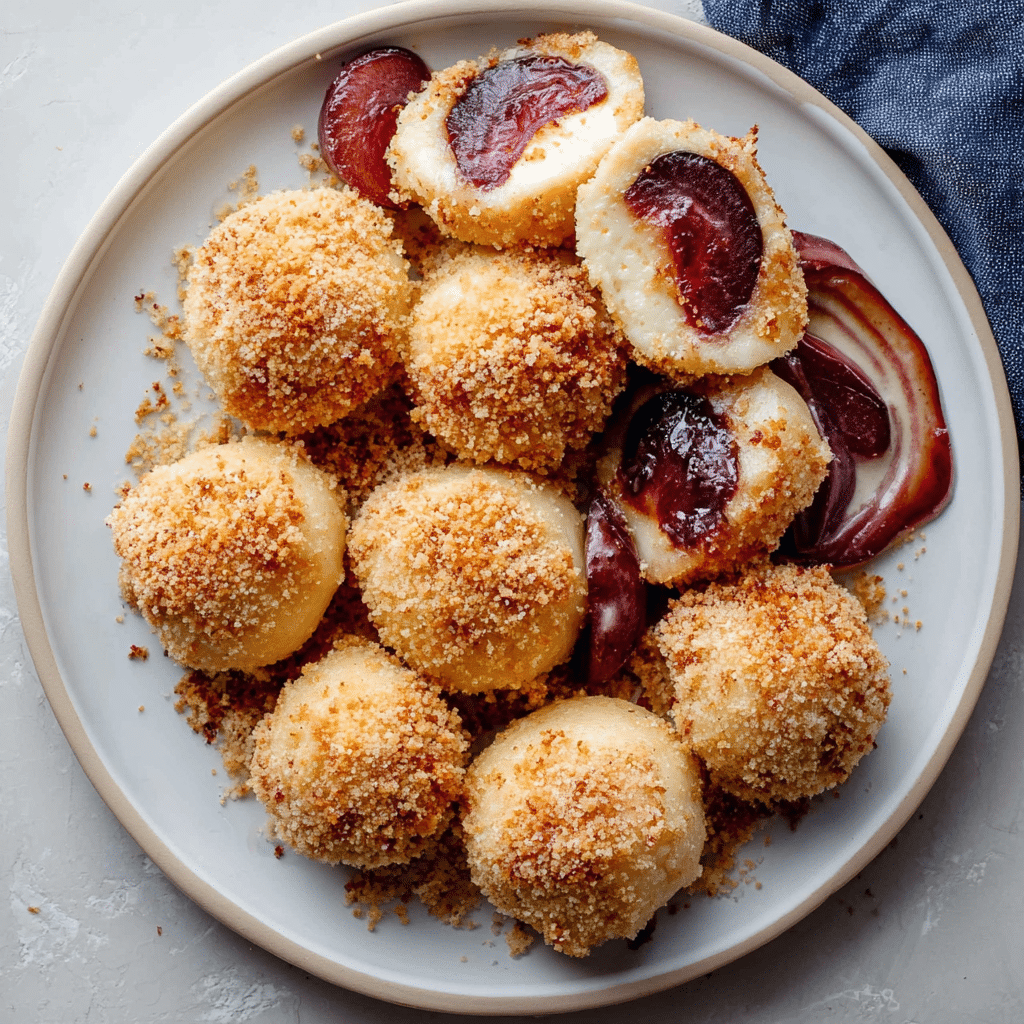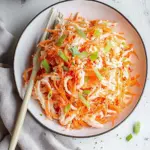These Ricotta Plum Dumplings are a dreamy blend of creamy cheese, pillowy dough, and juicy fruit. The cinnamon-sugar coating and buttered breadcrumbs give each bite a lovely crunch that complements the soft interior—and the scent of warm plums and cinnamon evokes cozy nostalgia and summer abundance.
Perfect for a relaxed weekend breakfast or an after-dinner indulgence, they’re surprisingly simple to make yet impressive to serve. Encasing fruit in soft ricotta dough adds a touch of elegance, making these dumplings an inviting treat for family gatherings or a sweet solo moment with a mug of tea.
Full Recipe
Ingredients:
-
2 cups all-purpose flour
-
1 tsp baking powder
-
1/2 tsp salt
-
1 tbsp sugar
-
1 cup ricotta cheese
-
1 large egg
-
1/4 cup milk (as needed)
-
12 ripe plums, halved and pitted
-
2 tbsp butter, melted
-
1/4 cup breadcrumbs
-
2 tbsp sugar + 1 tsp cinnamon (for coating)
Directions:
-
In a bowl, whisk flour, baking powder, salt, and sugar.
-
In separate bowl, combine ricotta, egg, and enough milk to form a soft dough.
-
Gently fold the dry ingredients into the wet until just combined – do not overmix.
-
Divide dough into 12 pieces. Encase each plum half in dough, sealing edges to create dumplings.
-
In a pan, toast breadcrumbs in butter until golden. Set aside.
-
Bring a pot of water to a gentle simmer. Add dumplings in batches; cook for 7–8 minutes until dumplings float.
-
Remove with slotted spoon, roll dumplings in cinnamon‑sugar mixture, then in toasted breadcrumbs.
-
Serve warm.
Prep Time: 20 minutes | Cooking Time: 15 minutes | Total Time: 35 minutes | Kcal: ~220 kcal per serving | Servings: 4
A Traditional Treat with a Twist
Ricotta Plum Dumplings are a delightful reinterpretation of a classic Eastern European comfort dish known in various cultures as knedle or gomboce. Typically made with potato dough and whole plums, this version elevates the dish by using ricotta cheese in the dough. The result is a lighter, more tender dumpling with a subtle creaminess that beautifully complements the juicy tartness of ripe plums. It’s a dish that blends tradition with modern culinary touches, offering a delicate balance between sweet and savory, softness and texture.
The Origins of Plum Dumplings
Plum dumplings are deeply rooted in Central and Eastern European culinary traditions. Countries like Hungary, Slovenia, Austria, and the Czech Republic all lay claim to variations of this beloved recipe. Traditionally, they were made as a way to stretch simple pantry ingredients into filling meals. The use of fresh plums—especially in late summer during harvest season—made them both practical and celebratory. They were often served as a main course or dessert and commonly enjoyed with a dusting of cinnamon sugar or a dollop of sour cream. Today, they remain a nostalgic comfort food for many families across Europe.
Why Ricotta Makes a Difference
Using ricotta cheese instead of potato transforms the traditional dumpling into something softer, fluffier, and slightly more indulgent. Ricotta brings a gentle tang and smooth texture, which helps the dough stay moist and tender after boiling. The natural richness of the cheese also balances the acidity of the plums, creating a more harmonious flavor profile. It’s a great choice for those looking for a slightly modernized version of the traditional dumpling that feels both luxurious and wholesome.
Perfect for Seasonal Ingredients
Plum dumplings are best made when plums are at their peak—late summer through early fall. The ideal plums for this recipe are small, ripe, and slightly tart, such as damsons or Italian prune plums. These varieties hold their shape well when cooked and offer a pleasant contrast to the sweet, pillowy dough. Seasonal cooking not only enhances the flavor of this dish but also connects you to the rhythms of nature and traditional foodways. By using local, in-season produce, you maximize taste and minimize food waste.
A Family-Friendly Experience
Making ricotta plum dumplings can be a wonderful family cooking project. Kids can help shape the dough, wrap the plums, and roll the cooked dumplings in the cinnamon-sugar and toasted breadcrumb coating. It’s a hands-on recipe that encourages togetherness in the kitchen and creates opportunities to pass down culinary heritage in a fun and approachable way. Even for those unfamiliar with Eastern European cuisine, this recipe offers a delightful entry point into a rich food tradition.
Serving Suggestions
These dumplings are best served warm, right after they’re coated in cinnamon sugar and buttery breadcrumbs. They make a fantastic dessert, but are also substantial enough to be served as a sweet main course. You can pair them with a drizzle of honey, a dollop of whipped cream, or even a scoop of vanilla ice cream for an extra indulgent twist. For a savory contrast, some traditional versions serve them with sour cream or crème fraîche. The beauty of this dish is its versatility—it can be rustic and homey or dressed up for a special occasion.
Texture and Flavor Profile
Ricotta plum dumplings offer a unique combination of textures: a soft, almost cake-like outer layer, a warm, juicy fruit center, and a crispy, buttery breadcrumb coating that adds contrast and depth. The light cinnamon-sugar blend used for coating adds a warm, spiced aroma and sweetness without overwhelming the natural flavor of the plums. Every bite delivers a blend of tangy fruit, soft dough, and fragrant coating, creating a multi-sensory experience that’s comforting and satisfying.
Cultural Significance
Beyond their delicious flavor, these dumplings carry a deep cultural significance. In many parts of Eastern Europe, plum dumplings are associated with family gatherings, seasonal harvests, and comforting meals passed down through generations. They often appear at festivals, Sunday lunches, and holiday tables. Making and sharing dumplings is a gesture of love and tradition, reinforcing the sense of community and shared history. Incorporating a ricotta-based variation can be a beautiful way to honor this legacy while adapting it for modern kitchens and dietary preferences.
Make-Ahead Tips and Storage
Although best enjoyed fresh, ricotta plum dumplings can be made ahead with a few considerations. You can prepare and shape the dumplings, then refrigerate them for a few hours before boiling. If you want to freeze them, it’s best to do so before cooking—lay them on a tray until solid, then store in an airtight container for up to a month. When ready to use, boil them from frozen, adding a couple of extra minutes to the cooking time. Leftover cooked dumplings can be reheated by gently pan-frying or steaming, though the breadcrumb coating may lose some of its crispiness.
Modern Variations and Substitutes
One of the joys of cooking is the ability to adapt recipes to your preferences and needs. For example, you can try different fruits like apricots, peaches, or even berries. Gluten-free flour blends can replace wheat flour for those with sensitivities, though adjustments may be needed for texture. Vegan versions can substitute ricotta with almond- or tofu-based alternatives, and plant-based butter can be used for toasting the breadcrumbs. These adaptations ensure that everyone can enjoy the essence of plum dumplings regardless of dietary requirements.
Conclusion: A Dish That Bridges Past and Present
Ricotta plum dumplings are more than just a dessert—they are a celebration of heritage, flavor, and creativity. Rooted in tradition yet flexible enough to accommodate modern tastes and ingredients, they are a perfect example of how food evolves over time while still preserving its soul. Whether you are reviving a family memory or trying something completely new, these dumplings invite you to slow down, savor seasonal ingredients, and enjoy the pleasure of a homemade sweet treat. In every bite, you’ll find a blend of cultures, generations, and heartwarming flavor that make them an unforgettable addition to your kitchen.






